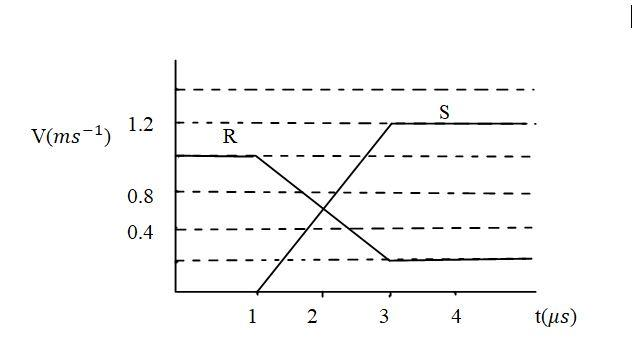
The diagram shows the velocity-time graph for two masses R and S that collided head on elastically. Which of the following statements is true?
I. R and S moved in the same direction after the collision.
II. The velocities of R and S were equal at the mid time of the collision.
III. The mass of R was greater than the mass of S.

A. I only.
B. II only.
C. I and II only.
D. I, II and III.
Answer
217.5k+ views
Hint: The momentum of a body is given by the product of mass and velocity. If a body changes its direction of motion then the velocity changes its sign, for example if the velocity is positive it gets negative and vice-versa.
Complete step by step answer:
It is given that two bodies R and S are colliding and the collision is head on and elastic, no information is given about the masses of body R and S.
We will consider each statement one by one and then get to the solution. Let us consider the first statement.
Statement 1:-R and S moved in the same direction after collision,
The statement says that the velocities of R and S are in the same direction, let us check if the statement is correct or not. In the graph after the elastic collision the velocities of both the masses are in the positive direction of the graph which means that the velocities of both the masses are in the same direction after collision.
Statement 2:- The velocities of R and S were equal at the mid time of the collision.
At the mid-time of collision the velocity-time curve of the two masses R and S intersect which means that at mid-time of collision the velocities of R and S are equal.
Statement 3:- The mass of R was greater than mass of S.
As after the collision the velocity of mass R is less than the mass of velocity S, and according to the principle of conservation of momentum, the momentum is conserved before and after the collision. So, if velocity is decreased then mass of R must be greater than mass of S, because momentum is given by $p = m \cdot v$.
So, all the three statements are correct and therefore, the correct answer is option D.
Note: Students should not get confuse in the third statement about which body has more mass the principle of conservation of momentum says, that the momentum of a body is conserved before and after collision, as the velocity of mass R is decreased therefore, the in order to conserve the momentum the mass of body R should be greater than the mass of body S.
Complete step by step answer:
It is given that two bodies R and S are colliding and the collision is head on and elastic, no information is given about the masses of body R and S.
We will consider each statement one by one and then get to the solution. Let us consider the first statement.
Statement 1:-R and S moved in the same direction after collision,
The statement says that the velocities of R and S are in the same direction, let us check if the statement is correct or not. In the graph after the elastic collision the velocities of both the masses are in the positive direction of the graph which means that the velocities of both the masses are in the same direction after collision.
Statement 2:- The velocities of R and S were equal at the mid time of the collision.
At the mid-time of collision the velocity-time curve of the two masses R and S intersect which means that at mid-time of collision the velocities of R and S are equal.
Statement 3:- The mass of R was greater than mass of S.
As after the collision the velocity of mass R is less than the mass of velocity S, and according to the principle of conservation of momentum, the momentum is conserved before and after the collision. So, if velocity is decreased then mass of R must be greater than mass of S, because momentum is given by $p = m \cdot v$.
So, all the three statements are correct and therefore, the correct answer is option D.
Note: Students should not get confuse in the third statement about which body has more mass the principle of conservation of momentum says, that the momentum of a body is conserved before and after collision, as the velocity of mass R is decreased therefore, the in order to conserve the momentum the mass of body R should be greater than the mass of body S.
Recently Updated Pages
Apparent Frequency Explained: Formula, Uses & Examples

Calorimetry: Definition, Principles & Calculations

Centrifugal Force Explained: Definition, Formula & Examples

Charge in a Magnetic Field: Definition, Formula & Examples

Charging and Discharging of a Capacitor Explained Simply

Combination of Capacitors: Series and Parallel Explained

Trending doubts
JEE Main 2026: Application Form Open, Exam Dates, Syllabus, Eligibility & Question Papers

Derivation of Equation of Trajectory Explained for Students

Hybridisation in Chemistry – Concept, Types & Applications

Understanding the Angle of Deviation in a Prism

Understanding Collisions: Types and Examples for Students

How to Convert a Galvanometer into an Ammeter or Voltmeter

Other Pages
JEE Advanced Marks vs Ranks 2025: Understanding Category-wise Qualifying Marks and Previous Year Cut-offs

Units And Measurements Class 11 Physics Chapter 1 CBSE Notes - 2025-26

NCERT Solutions For Class 11 Physics Chapter 8 Mechanical Properties Of Solids

Motion in a Straight Line Class 11 Physics Chapter 2 CBSE Notes - 2025-26

NCERT Solutions for Class 11 Physics Chapter 7 Gravitation 2025-26

Understanding Atomic Structure for Beginners




